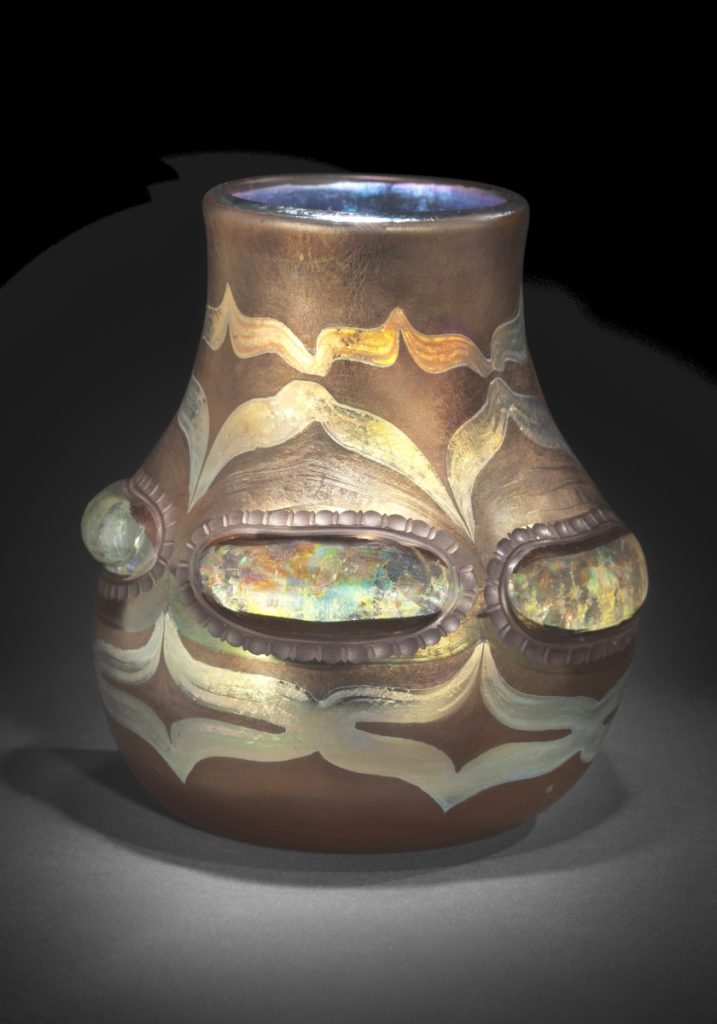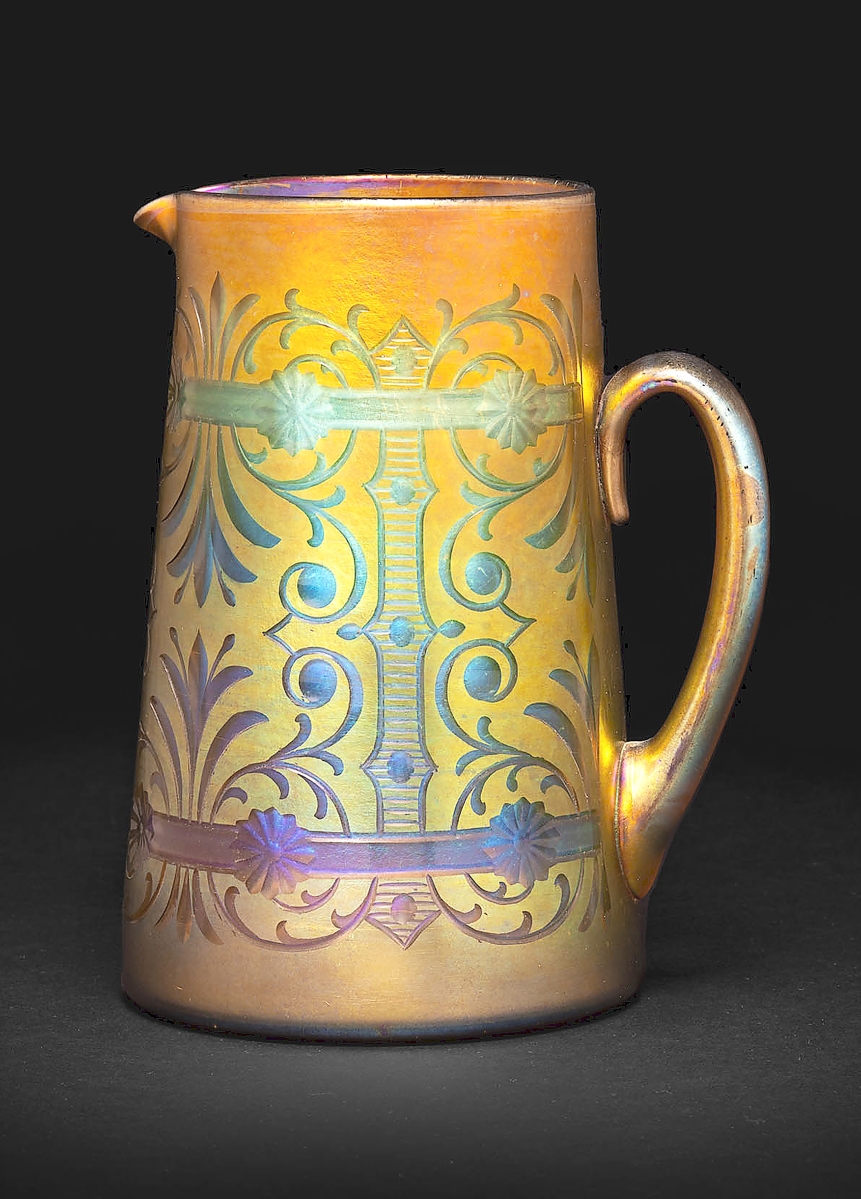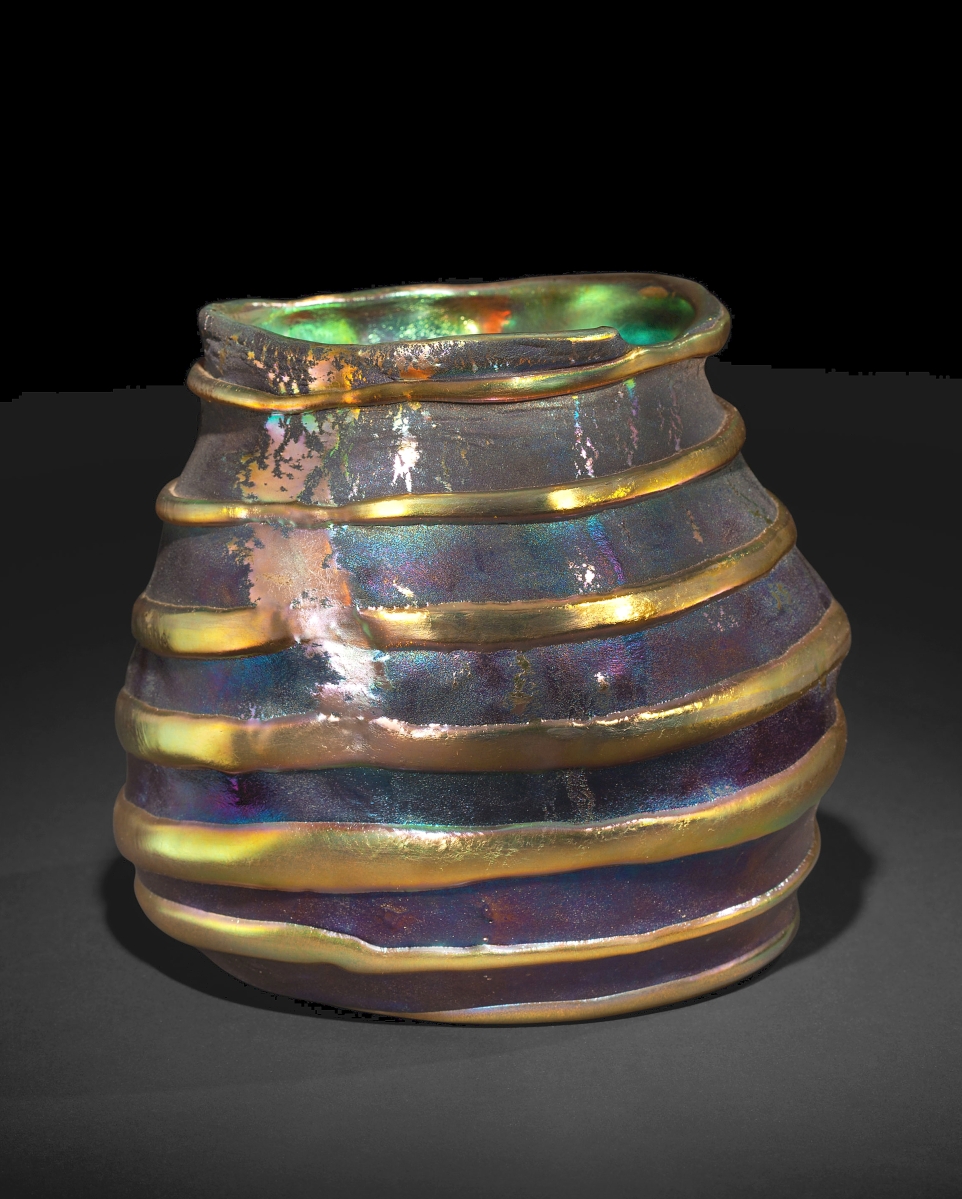
On December 7, Sotheby’s will auction in a single-owner sale works from the Doros Collection, all of which focus on the production of Louis Comfort Tiffany. The chance to speak to a seller about their collection and why they are choosing to sell does not come along every day, so we took this opportunity to reach out to Paul Doros, who worked closely with Sotheby’s, for some insights into the collection and the rationale behind the sale.
For the reader who may not be intimately familiar with the Doros Collection, can you give us an encapsulated view of the collection and its history?
The collection runs the full gamut of works created by Louis Comfort Tiffany and his various companies from around 1873 to the late 1920s. The focus is on the hand-blown Favrile vases (Favrile being the trademark Tiffany received for his revolutionary glass), but it also includes significant pieces of Tiffany pottery, metalware, enamels and mosaics. My parents – Jay and Micki Doros – were especially proud that they were among the first modern collectors to obtain Louis Tiffany’s paintings (he began his career as a professional artist) as well as the jewelry he designed for Tiffany & Company.
What was it about Louis Comfort Tiffany that so captivated your parents and, then, you?
It would probably be best to concentrate on the reasons my parents were so fascinated by the blown Favrile glass vases, which dominate the collection. I believe their initial attraction was to the extraordinary range of vivid colors, tones and hues in glass that ranged from transparent to opaque, combinations and features that were revolutionary when they first appeared in 1894. On top of that are the unusual shapes and weird and unexpected textures developed by Tiffany’s glassblowers and chemists. A piece of Tiffany glass really has to be handled to be fully appreciated. Then there’s the artificially applied iridescence that shimmers with gold, blue, violet or silver highlights depending on the lighting conditions. Perhaps rising above all the colors and textures and iridescences is the obviously superior craftsmanship of Tiffany’s glassworkers, who were among the finest in the world. Every piece is unique and presents its own sort of mystery. My father and I would spend hours trying to figure out how a certain vase was made, and for some of them we never could come up with a satisfactory solution.
On a personal level, this love of glass in general and, more specifically, Tiffany that I shared with my parents allowed me to have a very special bond with them. They always let me tag along when I was a young teenager as they visited dealers and auction houses while looking for the next great piece to bring home. Both Mom and Dad generously shared their knowledge and passion with me without hesitation. And my father, never one to be generous with his praise, was perhaps proudest when he told friends that he had created a curator.
On another level, as a trained historian, I became fascinated with Louis Tiffany’s life, the backgrounds of his employees, how the objects were marketed and other Tiffany-related topics too numerous to list. My appreciation for research was matched by my father’s, and both of us spent hours hunting for Tiffany-related ephemera and met with some degree of success. The number of documents he and I gathered, and that I continue to add to, now number more than 7,000 and, thankfully, my siblings have allowed me to keep this part of the collection in the family.

Rare Windows vase by Tiffany Studios, circa 1920, 5-1/8 inches high, one of only eight known examples ($40/60,000). —David Schlegel photo
How did your parents build their collection?
My parents, having grown up poor during the Great Depression (my father said the first step in his family’s chicken soup recipe was to steal a chicken), had no formal artistic education or training, and museums were places people with money visited. Mom and Dad got engaged in November 1948, married the following February and were young and in love. The fun and games soon ended as, beginning in 1952, Mom gave birth to four children in six years. They bought a small house in Springfield, N.J., and then my father decided to leave his accounting practice. He and a partner bought a wholesale tobacco and candy company, which began a 10-year period where he worked six days a week, 10-12 hours a day, and all the profits went back into the business.
Mom, however, insisted we take a family vacation each year and Dad reluctantly agreed. That meant two weeks in Bass River on Cape Cod the end of every August. We weren’t exactly poor, but there was no money for any type of extravagance, so free entertainment was crucial to keep us kids occupied. That meant days at the beach, foraging for blue crabs along the banks of the Bass River or going out into the wilds and picking buckets of beach plums, which Mom converted into jelly when we returned home. That was fine for when the weather was good, but what to do when it rained? The solution was to visit antique shops. Mom and Dad felt guilty about always looking and never buying, so they decided they would have to start collecting something and, for some unknown reason, they decided on cut glass knife rests. My parents soon became interested in all types of brilliant cut glass, and, within ten years, more than 600 pieces filled our rather modest New Jersey home.
My parents’ knowledge and appreciation of antique American glass was greatly expanded by numerous trips to the Corning Museum of Glass beginning in 1967, and the cut glass was soon augmented with all types of colorful art glass. It was a wonderful, eclectic and educational collection, but it was overtaking the house, and we all knew that Jay’s frenetic buying habits were not going to change.
Micki decided around 1976 that something had to be done, and quickly, and asked that I come home from Norfolk, Va., where I was the Chrysler Museum’s curator of glass, to lend my support. She then presented Dad with what was essentially an ultimatum but presented in her typically diplomatic style: either focus on a single glassmaker or start thinking about moving to a much larger house. Jay loved the house and, reluctantly, acquiesced. And fortunately for me, he decided to focus on Tiffany. All of the cut glass was then either donated to museums or sold at auction in order to provide more display space and also help finance new acquisitions.
Beginning on December 7, Sotheby’s will be selling the first of four auctions: The Doros Collection: The Art Glass of Louis Comfort Tiffany. Why sell?
I discussed the collection’s fate with my parents several times as they got older. My father, I think in jest but was never quite sure, said he wanted a pyramid built in the backyard where he and the glass could be entombed together. On a more serious and personal note, it is bittersweet to see the collection dispersed, as these are the pieces I grew up with and formed the basis of my love for all things Tiffany. However, I have always known that this day was inevitable. I have a brother and two sisters, and it would have been exceptionally difficult to divide the collection equitably. We are all very close and any other option besides selling the collection outright might have altered valued family relationships. It just isn’t worth taking the chance of that happening.

Favrile glass pitcher by Tiffany Studios, circa 1900, 7¾ inches high, first piece of Tiffany to enter my parents’ collection in 1972 ($1,5/2,000). —David Schlegel photo
What are some of the highlights of the auction?
First, let me say how grateful I am to Jodi Pollack, the co-worldwide head of Sotheby’s Twentieth Century Design department, for involving me in every step of the sale and cataloging process, including helping to decide what objects go into which auction. It was a totally unexpected privilege, and a lot of work, but it was an experience that I will long remember and hope to repeat three more times with Jodi and her team.
Not to be overly sentimental, but the one object in the auction that probably means the most to me is a relatively unimportant gold pitcher. It has a very ornate cut and engraved motif, and the bright iridescence covers the full spectrum of the rainbow. It’s certainly not the most expensive piece in the sale with an estimate of $1,5/2,000. It was, however, the first piece of Favrile glass to enter my parents’ collection in 1972 and I have a great emotional attachment to it.
Of much greater significance, and value, is a large and magnificent Lava vase formerly owned by Walter P. Chrysler Jr, a monumental millefiori vase that Tiffany displayed at the 1902 Turin Exposition, a stunning and rare Window vase, a massive Aquamarine vase probably made for the 1915 Panama-Pacific Exposition, and a number of pieces that were in Louis Tiffany’s personal collection.
Have there been revelations during the process?
Not in terms of provenance or history, as I’ve been researching these objects for a long time now. But the one revelation that did appear was a somewhat negative one. When my parents were collecting, all they had available for the detailed inspection of a piece of glass were a basic flashlight, maybe a spotlight, and sometimes a blacklight. Today, everyone has intense LED flashlights of near-blinding intensity. When Sotheby’s came to inspect the glass for the first time with these modern lights, previously unknown minor cracks were discovered in a couple of pieces. I wasn’t thrilled, as cracks tend to diminish a vase’s value, but obviously these will be disclosed in the condition reports.

Lava vase by Tiffany Studios, circa 1907,
6¼ inches high, formerly in the collection of
Walter P. Chrysler Jr ($70/100,000).
—David Schlegel photo
How has the field for Louis Comfort Tiffany evolved? Where do you see it headed?
Collecting trends for the works of Louis Tiffany and his firms is a fascinating study of examining how tastes come and go in this country. Revered as desirable and collectible works of art when they were first made, American tastes after World War I shifted away from the colorful Favrile vases to simpler, more symmetrical geometric designs. All things Tiffany were soon being derided as old-fashioned, objects that only your doddering grandparents could live with and appreciate. That began to change in the 1950s when Louis Tiffany’s role in creating a new, purely American art form was reevaluated and his work introduced to a new generation of collectors. Glenn Adamson has written a brilliant introductory essay for the auction catalog that goes into this specific topic in detail. Subsequent museum exhibitions and books on Tiffany have rightfully elevated him to his rightful place as one of the leading figures in the history of American decorative arts.
It’s always difficult to anticipate market trends, and collectors are notoriously fickle. However, a strong market for Tiffany’s creations has lasted for almost 75 years and I’m confident that the finest pieces will always be treasured and maintain their value.
Have dates for the remaining sessions been determined? When and what will be included in those sales?
The remaining three sessions are currently scheduled for June 2023, December 2023 and June 2024. Jodi has cleverly developed themes for each of them. This first sale will focus on Tiffany’s innovations and techniques. Future auctions will deal with abstraction, the natural world and, finally, Tiffany’s travels and explorations. The first three will primarily deal with Favrile glass, while the June 2024 event will feature Louis Tiffany’s paintings and jewelry.
– Madelia Hickman Ring




